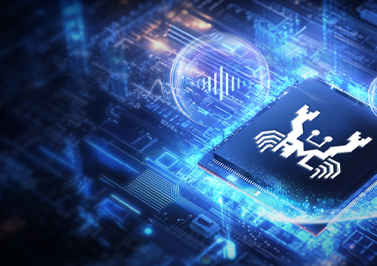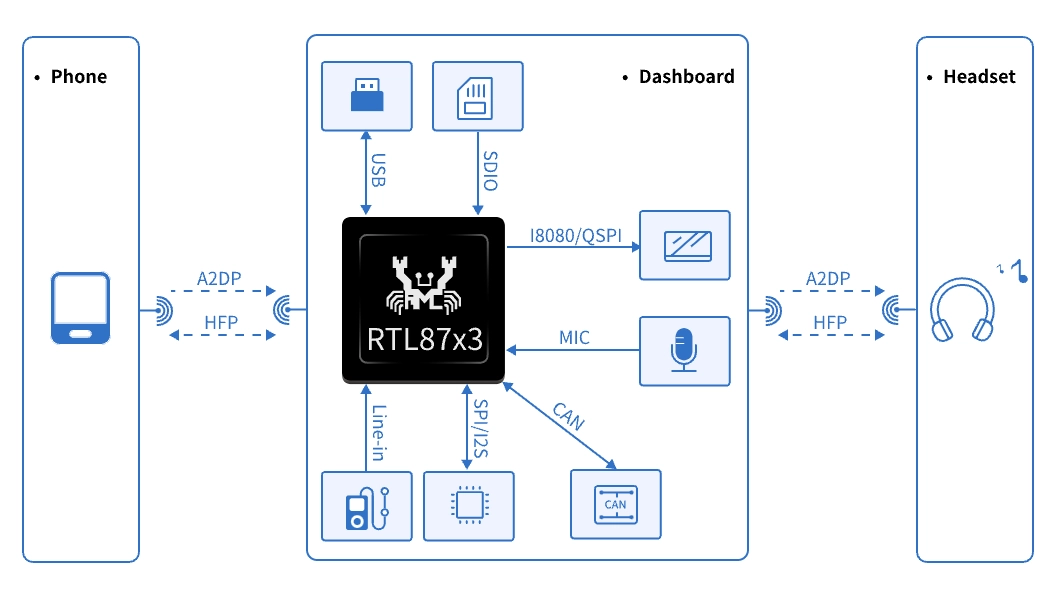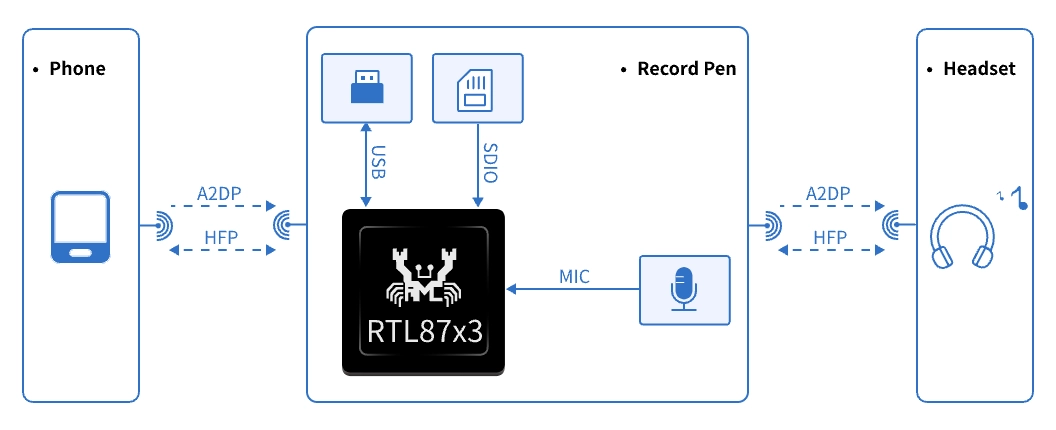

Solution Background
Realtek has introduced its latest Bluetooth single-chip dual A2DP/HFP audio solution, which is capable of supporting multiple roles under both protocols. This solution is applicable to a variety of application scenarios, including automotive audio and voice recording. It offers a rich set of interface options, such as USB, Line-in, SPDIF, I2S, SPI, SDIO, I8080, and QSPI, enabling flexible connectivity with various peripherals. It supports multiple audio sources and display devices, and can display audio parameters and device status in real-time and intuitively. Additionally, it provides convenient interactive operations to further enhance the user experience. Leveraging the powerful computing capabilities of high-performance MCUs and DSPs, customers can rapidly and flexibly develop a wide range of dual A2DP/HFP audio applications to meet diverse needs in different scenarios.
In the automotive audio scenario, the driver must keep both hands on the steering wheel to ensure safety. Operating mobile devices while driving poses a significant safety hazard. This solution supports both the Source and Sink roles in A2DP music streaming, as well as the AG (Audio Gateway) and HF (Hands-Free) roles in HFP (Hands-Free Profile) for hands-free calls. This enables convenient control of music playback and voice call functions without compromising driving safety.
In the voice recording scenario, recording devices such as Bluetooth record pens need to capture both voice communication and music data simultaneously. Traditional Bluetooth solutions often struggle to meet this dual-path requirement. This solution, however, supports both the A2DP Source and Sink roles, as well as the HFP AG and HF roles in the voice recorder application. It ensures the simultaneous capture and storage of audio signals during music playback and voice calls.

Solution Introduction
The RTL87x3 series SoC and SDK, through optimized parameter configuration, can support both A2DP Source/Sink and HFP AG/HF roles on a single chip. In music playback scenarios, the system can maintain two concurrent audio links for music data transmission. In call scenarios, it can also maintain two concurrent call links for voice data transmission.
In addition to these capabilities, the RTL87x3 series SoC supports Display interfaces. Even while handling dual audio or call data transmissions, it still provides sufficient processing power to drive external screen displays.
For near-field multi-device communication scenarios, this solution not only ensures the aforementioned data transmission capabilities but also offers superior anti-interference performance. Moreover, it can flexibly adjust audio and call parameters according to the specific requirements of different application scenarios.
Application Scenario
This solution can be widely applied to scenarios where multiple audio data streams exist and both master and slave devices need to be connected simultaneously, such as dashboards, smart helmets, and record pens.
Dashboard
The dashboard solution is applicable to the dashboard scenarios of two-wheeled vehicles such as motorcycles and electric bicycles. This solution integrates functions like music playback, voice calls, message display, and real-time control, which helps enhance the convenience and safety of operation while driving or riding.

By pairing the mobile phone and Bluetooth headphones with the dashboard device, the following functions can be utilized:
1. Music Playback
When music is played by clicking on the mobile phone, the audio signal will be transmitted and played through the Bluetooth headphones. The dashboard can display information about the currently playing music and provide an operational interface. Users can control music playback (start/pause) and adjust the playback volume by clicking on the dashboard.
2. Voice Call
When a call is received on the mobile phone, the voice signal will be transmitted and played through the Bluetooth headphones. The Bluetooth headphones can also capture audio input, enabling two-way voice signal transmission. The dashboard can display information about the ongoing call and provide an operational interface. Users can answer/end the call and adjust the call volume by clicking on the dashboard.

Smart Helmet
The smart helmet solution is widely applicable to outdoor cycling scenarios. It integrates functions such as music sharing and playback, navigation, and voice call assistance. This solution enables the sharing of trip information, significantly enhances the cycling experience, and helps riders maintain focus, thereby improving riding safety.

By pairing the mobile phone with Helmet 1 and then pairing Helmet 1 with Helmet 2, the following functions can be utilized:
1. Music Sharing
The music played on the mobile phone will be simultaneously output through Helmet 1 and Helmet 2. The buttons on Helmet 1 can control the music sharing function with Helmet 2. In addition, both Helmet 1 and Helmet 2 can control music playback (play/pause) and volume adjustment through their respective buttons.
2. Voice Intercom
Helmet 1 and Helmet 2 can engage in voice intercom and exchange cycling information. This is achieved by establishing a communication link for two-way voice signal transmission between the two helmets. Functions such as answering/ending calls and adjusting call volume can be controlled via button clicks on the helmets.

Record Pen
The record pen solution is widely applicable to scenarios such as meeting recording, interviews, and study sessions. It includes functions such as microphone recording and storage, music recording, and call recording. This solution is equipped with a large-capacity storage module, which is capable of saving recorded files.

By pairing the mobile phone and Bluetooth headphones with the record pen device, the following functions can be utilized:
1. Microphone Recording and Storage
Pressing the button on the record pen will initiate recording and simultaneously save the recorded audio file. The currently supported recording formats include PCM, OPUS, and others.
2. Music Recording
When music is played on the mobile phone, the audio can be transmitted to the headphones via the record pen. The record pen will simultaneously save the audio data to the local storage card. Functions such as starting/pausing music playback and adjusting playback volume can be controlled by pressing buttons on the record pen.
3. Call Recording
When a call is received on the mobile phone, the voice signal will be played through the Bluetooth headphones. The record pen will simultaneously save the voice call data to the local storage card. Functions such as answering/ending the call and adjusting call volume can be controlled by pressing buttons on the record pen.

Solution Advantages
1. Single-Chip Architecture
By optimizing system parameters, the single-chip architecture achieves a well-balanced trade-off among cost, bandwidth, and functionality.
2. Abundant Peripheral Support
The solution supports a wide range of audio input and output interfaces, including MIC, USB, Line-in, SPDIF, SDIO, SPI, and I2S.
3. Sufficient MCU Resources
The MCU and DSP resources enable rapid multitasking response and efficient processing of audio algorithms.
4. Diverse Application Scenarios
The solution is widely applicable to scenarios that require simultaneous support for dual roles of A2DP and HFP.
5. Comprehensive Development Kit
The complete SDK development package includes various product prototype projects, allowing customers to simplify the development process and build upon these foundations.
Outlook
Realtek's Bluetooth single-chip dual A2DP/HFP audio solution integrates Realtek's state-of-the-art Bluetooth technology, offering superior performance and multifunctional advantages. It meets users' demands for high-quality audio transmission and clear voice calls. The solution supports a variety of interface options for easy integration with different devices. Its compact design makes it highly suitable for applications in various scenarios, such as dashboards, helmets, record pens, and smart wearable devices.
With its significant technological advantages and broad applicability, this solution provides a comprehensive audio solution for users, helping products stand out in the market and paving the way for a new era of intelligent audio.
Example Application
The Realtek Bluetooth SDK provides an example application that demonstrates the dual A2DP/HFP audio solution. It also includes a detailed application note for developers to refer to during the development process. For more details, please refer to
The code related to music playback can be referenced in
sdk\src\sample\bt_audio_trx\source_play\app_src_play_a2dp.c
The code related to voice calls can be referenced in
sdk\src\sample\bt_audio_trx\source_play\app_src_play_hfp.c
The code for local music playback can be referenced in
sdk\src\sample\bt_audio_trx\source_play\app_src_playback.c
Terminology Definitions
A2DP
A2DP is a Bluetooth protocol used for the wireless transmission of high-quality audio. Under the A2DP framework, there are two roles:
1. Audio Source: The device that sends the audio signal, responsible for transmitting the digital audio stream to the receiving device. Typical devices include smartphones, computers, or tablets.
2. Audio Sink: The device that receives the audio signal, responsible for receiving and playing the digital audio stream from the sending device. Typical devices include Bluetooth headphones or speakers.
HFP
HFP is a Bluetooth hands-free profile used to support hands-free telephony functions. Under the HFP framework, there are two roles:
1. Audio Gateway: The core device for audio input/output, responsible for managing calls and controlling audio data responses. Typical devices include smartphones or computers.
2. Hands-Free Unit: The device paired with the audio gateway, responsible for communicating with the gateway to enable hands-free calling functions. Typical devices include automotive Bluetooth systems or Bluetooth headphones.



 苏公网安备32059002006558号
苏公网安备32059002006558号